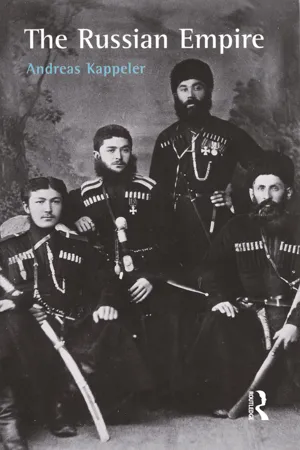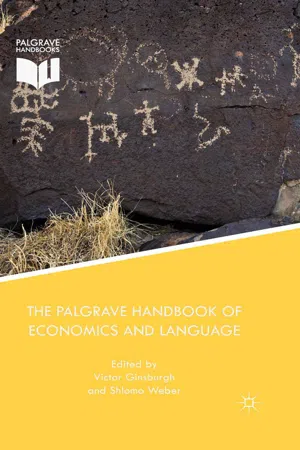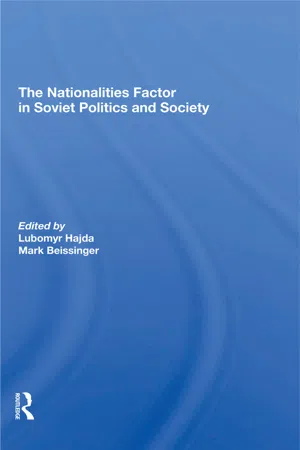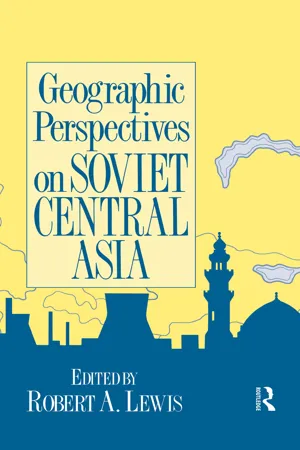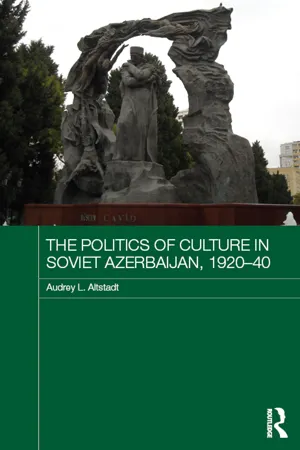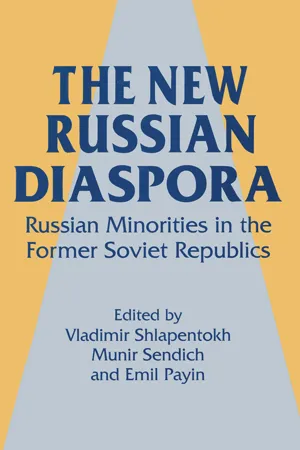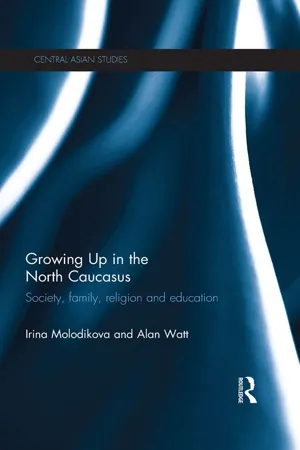History
Russification
Russification refers to the policy of the Russian Empire and later the Soviet Union to promote Russian culture, language, and identity among non-Russian nationalities within its borders. This often involved suppressing local languages and traditions in favor of Russian ones. Russification aimed to assimilate non-Russian populations into the dominant Russian culture and was a source of tension and resistance in many regions.
Written by Perlego with AI-assistance
Related key terms
Related key terms
1 of 4
Related key terms
1 of 3
7 Key excerpts on "Russification"
- eBook - ePub
The Russian Empire
A Multi-ethnic History
- Andreas Kappeler(Author)
- 2014(Publication Date)
- Routledge(Publisher)
In the course of the nineteenth century a number of new factors appeared on the scene, and these changed the traditional policy patterns. The two most important ones have already been discussed in the previous chapter. The national movements of the non-Russians, first and foremost that of the Poles, and national consciousness in sections of Russian society began to jeopardize the basis of the dynastic legitimation of the multi-ethnic empire and its estate-based and pre-national policies. To this was added the increasingly urgent need to modernize the empire, something that was linked to an administrative, judicial and social process of systematization and regularization. Finally, Russia was affected by changes in the rest of Europe, where the model of the ethnically uniform nation state was gaining ground. That this could also be applied in multi-ethnic empires was demonstrated by the policy of germanization which followed the unification of Germany, and the policy of magyarization which occurred after the Austro-Hungarian ‘Compromise’ of 1867.Russian policy was influenced by these new forces, and the tendency towards swift administrative, social and cultural integration became stronger, and culminated towards the end of the nineteenth century in what was known as the policy of Russification. However, the widely held view among historians that there was such a thing as a simple and one-dimensional policy of Russification which began at the latest under Nicholas I needs to be differentiated in what follows in both regional and chronological terms.1 Furthermore, it needs to be asked to what extent, as the title of this chapter suggests, there was in fact a single - eBook - ePub
- V. Ginsburgh, S. Weber, V. Ginsburgh, S. Weber, V. Ginsburgh, S. Weber(Authors)
- 2016(Publication Date)
- Palgrave Macmillan(Publisher)
In this context, the spreading of the knowledge and use of Russian was regarded as one possible way to ensure greater socio-cultural, economic and legal integration within the Russian Empire. The policy of Russification involved both the standardization of laws and regulations used throughout the empire (and thus the elimination of the remaining bits of political-administrative autonomy in non-Russian parts of the empire) and the forceful and rapid introduction of the Russian language in education and administration in various part of the empire, often regardless of whether there were objective preconditions for the success of such a policy (including the accessibility of education), along with restricting the use of other languages. In many areas this language policy represented a radical turn away from a relatively more flexible and gradual approach that was used during the previous decades, which predictably raised opposition among the ethnic minorities and the new political forces that represented them.The ineffectiveness of the state language policy aimed at expanding the use of the Russian language eventually became obvious. It had its roots in the limited and inconsistent nature of the state educational policy that did not envision universal and accessible education for all social classes. To spread the Russian language without actually spreading education was a task doomed to fail. The attempts to solve the task of spreading the use and knowledge of it among non-Russian subjects in a fast and radical were not very successful. Instead of integrating people of other ethnicities with the Russians it alienated them, starting from parents of children who were deprived of the opportunity to get primary education in a language which they understood, to national intelligentsia who saw in it a threat to ethnic uniqueness, to local political and business circles who were not willing to surrender their position routed in part in the use of local languages.At the turn of the century, the Russian Empire faced the escalation of social and political unrest. The discontent with the political and economic realities of late tsarism was growing all over the nation and concentrating in the capitals and major cities. The demands for civil freedom, political reforms and social justice were voiced throughout the empire. In the ethnic periphery they also included demands for national autonomy and/or independence and, at the very least, for greater rights and opportunities to use native languages in administration, publishing and education. The issue of languages was destined to become a recurring theme in the agenda of the emerging nationalistic political movement and parties in the context of the radical language policy of Alexander III and his heir Nicholas II. The authorities made a few concessions in the wake of the revolution of 1905–1907. These included for instance greater opportunities for education in native languages at the primary level (in 1905 the Committee of Ministers of the Russian Empire allowed using local languages in teaching arithmetic). The extent of these concessions was, however, limited. - Lubomyr Hajda, Mark Beissinger(Authors)
- 2019(Publication Date)
- Routledge(Publisher)
CHAPTER 5 Some Factors in the Linguistic and Ethnic Russification of Soviet Nationalities: Is Everyone Becoming Russian? Barbara A. Anderson and Brian D. SilverLanguage and ethnic affiliation are the most important determinants of the non-Russian peoples' identity in the USSR. Given the country's multiplicity of nationalities, and the political ramifications of this diversity, changes in language behavior and ethnic attachments have significant long-term implications for the Soviet state and society.Changes in language behavior and ethnic identity of a population seldom take place quickly. When they do occur, it is often an intergenerational process. The levels and rates of assimilation among the Soviet nationalities are influenced by a variety of factors. Regime policies are one, but even sudden shifts in policy often produce an effect only gradually. They are, in any case, not necessarily determinative, for the varying levels of development and the specific experiences of particular groups also play an important role. There is, as well, the impact of critical historical events that may precipitate a process of unforeseen change that becomes fully apparent only after the passage of considerable time.1Our study examines the linguistic and ethnic assimilation of the non-Russian nationalities in the Soviet Union in this light, focusing on a few elements of the process that are important but not well understood.2The Extent of Linguistic Russification
The Soviet censuses of 1959, 1970, 1979, and 1989 each asked every respondent's native language (rodnoi iazyk), with parents answering for young children. This question was supposed to elicit the language that the respondent knew best, not necessarily that which he or she had learned first, and did not have to match his or her self-identified nationality.3- eBook - ePub
- Robert Lewis(Author)
- 2003(Publication Date)
- Routledge(Publisher)
12 Linguistic Russification is used as one measure of acculturation, since the adoption of the tangible attributes of another nation as one's own is the hallmark of this preliminary stage in the process of international integration. However, as was noted above, acculturation does not signify the loss of national self-consciousness, nor is it alone a sufficient condition for psychological assimilation at some later date. Linguistic Russification, even where it is found to be extensive, may be the terminal point in the process of international integration, and even this tentative step may be reversed at some later date.Linguistic assimilation to the indigene's language (for example, to Uzbek in Uzbekistan) may also occur. This aspect of acculturation has rarely been explored, but is included in this analysis in an effort to assess the relative status the indigenous language enjoys in the national homeland. If linguistic “Russification” may be equated with acculturation toward the dominant nation in the state, linguistic assimilation to the indigenous language is indicative of the preferential position attained by the indigenous nation within its homeland.Linguistic Russification
Learning Russian as a second language has not led to linguistic “Russification” in Central Asia. Indeed, the introduction of a question on second language fluency in the 1970 census appears to have resulted in a decline or an extremely minimal increase in linguistic “Russification” between 1959 and 1970 for members of each nation who resided in the national homeland. This decline or low growth was of course more apparent than real, and indicates that the choice of first language is not necessarily made solely on the basis of fluency level, but may be influenced by the international climate at the time of the census (Silver 1987b: 79–80).Spatial variations in the rate of linguistic Russification among Central Asians do exist (Table 11.7 - Audrey Altstadt(Author)
- 2016(Publication Date)
- Routledge(Publisher)
83 [Emphasis added.] This policy constituted a formula for the adaptation of the party’s cultural program within the framework of the national question. It transformed cultural policy that was conceived for and applied to Russian culture and population into the Russification of non-Russian cultures. There is no pretense that it was anything else. If “raising the cultural level” was the party’s second task, it largely contradicted the first. Great Power chauvinism was banned, but Russian proletarian chauvinism became the order of the day.Third was the struggle against “local nationalism” of titular nationalities of Soviet Socialist Republics (SSRs) against other minorities. Survivals of this consciousness manifest themselves in “national alienation and the absence of full confidence of the formerly oppressed peoples toward measures put forth by Russians.” Because national resistance by non-Russians was rooted solely in past oppression by a regime (the tsarist) that no longer existed and a class (the Russian bourgeoisie) that no longer ruled, it had no validity.84 In contrast, resistance to the Russian proletariat was counter-revolutionary. Through this line of argument, the path was open to the full suppression of non-Russians’ nationalism. As national forms were strengthened, national content was undermined.The Resolution placed blame for national tensions not on flawed policies, but on guilty individuals. The Russian chauvinism of officials interfered with the recruitment of communist cadres from the local population. Again the solution to the problem stressed forms. Special laws, pledged the Resolution, would protect the right “to use the native language in all state organs”.85 Neither the term “nativization” nor korenizatsiia (literally “rooting”) appeared in the resolution. The 12th Congress is considered to have formally initiated the policy of korenizatsiia- eBook - ePub
The New Russian Diaspora
Russian Minorities in the Former Soviet Republics
- Vladimir Shlapentokh, Munir Sendich, Emil Payin(Authors)
- 2016(Publication Date)
- Routledge(Publisher)
Imperial rule in the colonies rested on officialdom, to which the Christian clergy also belonged. In Turkestan and other Muslim colonies, nonofficial relationships between Russian functionaries and the local population were practically nonexistent. In Ukraine, Transcaucasia, Poland, and even in the Baltic states, Russian officials had rather close relations with the local aristocracy and rich city dwellers. Mixed marriages were also common.Naturally, the administration was the venue of the Petersburg-based policy of Russification of the colonies. Especially active in this respect were the two last Russian emperors. As George Fedotov justly remarked, as “pupils and victims of reactionary Slavophilism, they did much to hasten the future disintegration of their empire.”9The numerically weak democratically minded intellectuals in the colonies did their best not to identify themselves with government policy. The enlightened activities of these intellectuals (e.g., the setting up of national schools, hospitals, and first-aid stations) were analogous to the work of the missionaries in the colonies of West European states. It has long been stated that in the Russian Empire the Russians were not in fact an imperial people since, first, they gained nothing from their position as the ruling nation, and second, they did not share the imperial ambitions of the elite.It should be noted that the living standards of the Russians living in the mother country and in the colonies were different. For instance, the standard of living of Russian peasants in the non—Black Soil zone was as a rule lower than that of the Estonian, Latvian, and Ukrainian peasants, while in Siberia the Russian settlers lived better. The living standards of the Cossacks were much higher than those of their Chuvash neighbors, and the land tiller in the not-so-rich non-Black Soil Russia was also richer than his Chuvash neighbor.As for the issue of imperial ambition, it should be pointed out that although Russian people did not share the ambitions of the tsars and bureaucrats, they freely shed their own blood as well as the blood of other nations in fighting for these ambitions and conquering many other peoples and states on the tsar’s behalf.2. Political and Economic Forms of Russian-Soviet Colonial Expansion
- eBook - ePub
Growing Up in the North Caucasus
Society, Family, Religion and Education
- Irina Molodikova, Alan Watt(Authors)
- 2014(Publication Date)
- Routledge(Publisher)
Schools for various ethnic groups in the region, with teaching in languages other than Russian, were another significant element in the development of education in the Empire period. Many ethnic minorities from outside the region who came with colonization (notably Germans, Lithuanians, Latvians, Poles and Estonians) or increased their presence (Armenians, Greeks and Jews) established their own community schools in their native languages. The indigenous populations, in most cases with little tradition of formal education prior to the Russian invasion, were more reliant on state provision, which generally meant mixed (native and Russian) language teaching at primary level and Russian-language education at secondary level.Official policy towards ethnic education was differentiated according to ethnic group: most support was given to Russian-language and Orthodox education; some state provision was made for indigenous schools on language teaching, though only at the primary level and, even by the end of the Empire period, not in the numbers needed; while efforts were made especially in the later nineteenth and early twentieth centuries to force non-indigenous ethnic groups to bring their children within the state system (including attempts to close ethnic minorities’ schools in the case of Armenian and German communities) because the government feared the development of separatism and nationalism. Throughout this period, the various ethnic minorities tried to limit the influence of Russian state education. The goal of the Russian government was the unification of the school process and certification of teachers as civil servants. But the conclusion of the Department of Spiritual Affairs of the Ministry of Interior on ethnic schools was that ‘governmental requirements at local level are not fulfilled’ (Tkachenko 2009: 210). For the indigenous population the Ministry of Education stated: ‘The use of local languages in schools is unavoidable, whether we allow it or not’ (Tkachenko 2009: 18).
Index pages curate the most relevant extracts from our library of academic textbooks. They’ve been created using an in-house natural language model (NLM), each adding context and meaning to key research topics.
Explore more topic indexes
Explore more topic indexes
1 of 6
Explore more topic indexes
1 of 4
